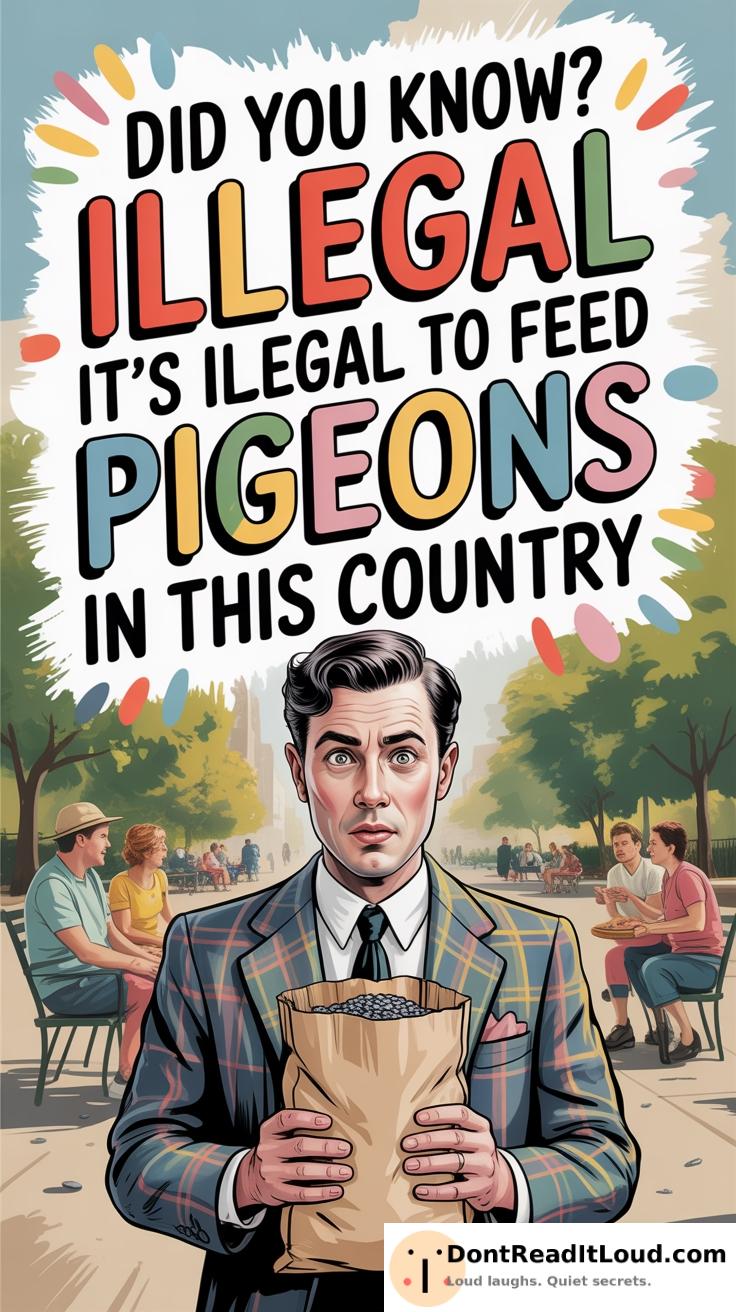
Did you know feeding pigeons is illegal in countries like Venice and Singapore? These laws help protect public health, urban spaces, and cultural heritage from the problems caused by large pigeon populations. Such regulations reflect local values around preservation and cleanliness. Violators may face fines or be required to complete community service. Other countries might find similar laws useful for maintaining their public spaces. Discover how these rules help balance heritage and health.
The Origin of This Law

The laws prohibiting the feeding of pigeons have their roots in historical and practical concerns, mainly related to public health and city management.
For instance, in many European cities such as Venice, laws against feeding pigeons date back to the early 20th century. In Venice, authorities responded to health risks caused by dense pigeon populations in crowded urban settings. Pigeons were linked to disease transmission, and their droppings damaged historic buildings and monuments. The law aimed to protect Venice’s architecture and control bird numbers.
In the United States, similar regulations appeared in cities like New York and San Francisco around the 1950s. These rules focused on keeping public spaces clean and reducing the costs of removing pigeon droppings. Accumulated droppings were both unsightly and a hazard, spreading germs and increasing the risk of accidents on sidewalks.
Feeding pigeons also leads to population growth, as easy food access encourages more breeding. This worsens problems like noise, mess, and disease risks. As cities grew and urban planning improved, officials saw the need to manage pigeon feeding to maintain cleaner and safer public spaces.
Economic considerations influenced these laws as well. In cities with many tourists, pigeon-related cleanup and repairs became expensive for local governments. By restricting pigeon feeding, cities hoped to lower these costs and use resources more effectively.
Why This Law Exists

Feeding pigeons is prohibited in many countries for a mix of practical, cultural, and political reasons. Understanding the persistence of this law requires looking at these factors:
- Practical Motivations:
- Public Health Concerns: Pigeons can spread diseases like histoplasmosis, cryptococcosis, and psittacosis to humans. Restricting feeding helps control their numbers and lowers health risks.
- Environmental and Property Damage: The acidity in pigeon droppings damages buildings, monuments, and infrastructure, leading to high maintenance costs and harming city aesthetics.
- Urban Wildlife Management: Excess food encourages larger pigeon populations, which disrupts local ecosystems and upsets the balance of urban wildlife.
- Cultural Motivations:
- Preservation of Historical Sites: Protecting monuments and historic buildings is essential in many cities. Limiting pigeons helps safeguard these structures from erosion and decay.
- Public Spaces: Many cultures cherish clean, welcoming public areas. Large pigeon flocks can make these spaces less pleasant and accessible due to mess and aggressive behavior.
- Political Motivations:
- Regulatory Compliance and Enforcement: Enforcing bans on feeding pigeons shows a government’s commitment to managing city spaces and protecting public health.
- Public Support and Awareness: Such laws often respond to calls for tidier, safer urban areas. Education campaigns may also inform citizens about the problems caused by overfeeding pigeons.
How This Law Reflects it’s Culture?

Feeding pigeons might seem harmless, but in many countries it’s regulated, often for reasons that reveal deeper cultural values and norms. Let’s explore how a law like this reflects Italian culture, especially in Venice where feeding pigeons is banned.
- Preservation of Historical Heritage: Italy deeply values its history and art. Many landmarks are threatened by pigeon droppings, so banning pigeon feeding helps protect these sites. This reflects Italy’s commitment to safeguarding its cultural and historical treasures.
- Community Well-being: Italian society puts a high priority on public health. Since pigeons can spread diseases, limiting their numbers helps create a healthier environment. This demonstrates Italy’s concern for the health and safety of its people.
- Aesthetic Values: Italians have a strong appreciation for beauty and cleanliness in their cities. Pigeons often dirty public spaces and disrupt the atmosphere with noise. By banning feeding, Italy maintains the visual appeal and order of its public areas.
- Respect for Rules and Regulations: Following rules is important in Italian culture to support social harmony. The enforcement of this law highlights an expectation that regulations are respected for the collective benefit.
What Happens If You Break This Law?

In many countries, feeding pigeons is regulated due to concerns about public health, cleanliness, and the birds’ welfare. If someone breaks this law, several outcomes may occur, depending on local rules.
- Fines: The most common result of feeding pigeons in restricted areas is a fine. The amount depends on the location and can range from $50 to several hundred dollars. Repeat violations may lead to higher fines.
- Legal Consequences: In some places, continuing to break the law could mean going to court. Serious or repeated offenses might result in community service or other court-ordered penalties.
- Public Reaction: Community response to feeding pigeons can vary. Some people welcome strict enforcement to protect public spaces, while others feel the laws are too harsh. Public opinion sometimes shapes how strictly these rules are applied and can inspire local campaigns for or against the regulations.
- Educational Consequences: Sometimes, instead of—or along with—a fine, offenders must attend educational sessions. These programs explain the problems caused by feeding pigeons, such as overcrowding, disease, and environmental harm.
- Social Stigma: In certain communities, being caught feeding pigeons can lead to embarrassment or criticism, especially where the issue is serious. This social pressure may encourage people to follow the rules.
Could Other Countries Learn from This Law?

Feeding pigeons is an activity that, while seemingly innocuous, can lead to significant urban challenges. Various countries have enacted laws to manage or prohibit the feeding of pigeons in public spaces, each taking unique approaches based on their specific cultural, environmental, and urban contexts.
Let’s examine how different countries handle this issue and whether others can glean insights from these laws.
United Kingdom:
In the UK, particularly in cities like London, feeding pigeons is discouraged due to the health risks associated with pigeon droppings and the potential for overpopulation. The Royal Parks Regulations strictly prohibit feeding birds in certain areas, such as Trafalgar Square, where feeding bans have been in place for years.
Authorities emphasize public education campaigns to inform citizens about the negative consequences of feeding pigeons.
Italy:
In Venice, a city facing severe pigeon overpopulation issues, feeding these birds is illegal. The law is in place to protect the city’s architectural heritage from damage caused by pigeon droppings.
The enforcement of this regulation is quite strict, with fines imposed on violators. Venice’s approach is a preventive measure to preserve its cultural landmarks, which is a priority for this unique city.
Singapore:
Singapore takes a stringent approach to urban cleanliness, including laws against feeding pigeons. The city-state enforces fines for feeding pigeons, and public awareness campaigns are frequent.
Singapore’s law is part of its broader strategy to maintain its reputation as a clean and green city, and it’s highly effective due to the country’s well-established regulatory environment.
United States:
In the United States, policies on feeding pigeons vary by city. New York City, for example, doesn’t have a citywide ban, but individual parks and public spaces often have specific regulations.
The approach in the U.S. tends to be less uniform, with local governments setting rules based on community needs and environmental considerations.
Can Other Countries Learn from These Laws?
Countries can certainly learn from these examples, especially regarding the balance between maintaining public health and preserving cultural sites.
The key lessons include:
- Public Education: Effective public education campaigns are essential. As seen in the UK and Singapore, informing the public about the consequences of feeding pigeons helps change behavior and reduce enforcement burdens.
- Cultural Sensitivity: Laws should consider cultural contexts. In cities like Venice, where preserving architectural heritage is paramount, strict regulations are justified and accepted by locals and visitors alike.
- Enforcement and Penalties: Consistent enforcement and appropriate penalties, as seen in Singapore, are necessary to deter feeding and maintain compliance with regulations.
- Tailored Solutions: Every city has different needs. Laws should be adaptable to the specific challenges and priorities of each urban area, ensuring they’re both practical and effective.
While the core principles of these laws can be applied universally, the specifics need to be tailored to fit each country’s unique circumstances.
Hence, while countries can learn from these examples, they should also consider their local context in crafting appropriate legislation.
Conclusion: What Makes this Law So Unique
The law regarding pigeon feeding in certain countries stands out for its distinctive approach to managing urban wildlife and maintaining public cleanliness. Unlike places where regulations are lax or rarely enforced, this law is both strict and meaningful within its cultural context.
It addresses the ecological and public health risks that arise from pigeon overpopulation in cities.
What sets this law apart is its comprehensive enforcement, which often includes significant fines and ongoing public education to promote adherence. Such thorough regulation is rare and serves as an example for effective urban wildlife management.
By focusing on cleanliness and public health, the law shows a forward-thinking commitment to environmental care and civic duty.
Other countries might benefit from adopting similar measures, balancing human interaction with wildlife while ensuring cities remain healthy and clean.
The cultural significance of this law reflects a dedication to safeguarding both city life and natural ecosystems, offering guidance on how legislation can tackle comparable issues worldwide.



